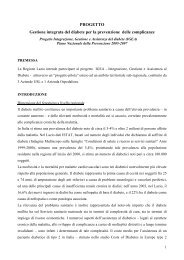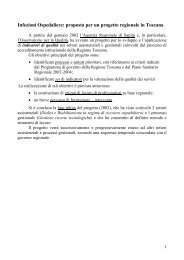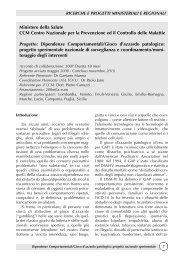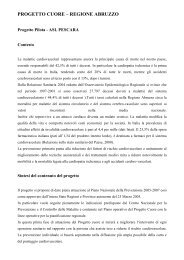Gaining health : analysis of policy development in European ...
Gaining health : analysis of policy development in European ...
Gaining health : analysis of policy development in European ...
Create successful ePaper yourself
Turn your PDF publications into a flip-book with our unique Google optimized e-Paper software.
Chapter 4<br />
78<br />
A characteristic feature <strong>of</strong> the fragmented public <strong>health</strong><br />
<strong>policy</strong> is that there are currently 35 national programmes<br />
<strong>in</strong> force <strong>in</strong> France, sett<strong>in</strong>g different priorities for improv<strong>in</strong>g<br />
the <strong>health</strong> <strong>of</strong> the population. Accord<strong>in</strong>g to the pr<strong>in</strong>ciple <strong>of</strong><br />
subsidiarity, the construction <strong>of</strong> the programmes is ma<strong>in</strong>ly<br />
top-down and the regions are expected to represent national<br />
priorities <strong>in</strong> their regional action plans and to organize<br />
projects <strong>in</strong> accordance with them. However, the necessary<br />
facilities and f<strong>in</strong>ancial resources are <strong>of</strong>ten not provided and<br />
national programmes cannot be adapted to the regional<br />
level.<br />
In 2004, after many reforms and attempts at improv<strong>in</strong>g<br />
the system, the Public Health Act was passed <strong>in</strong> order to<br />
ensure a general framework with clear priorities and directions<br />
for a national and regional public <strong>health</strong> <strong>policy</strong> over a<br />
five-year term.<br />
2.2. Awareness build<strong>in</strong>g and consultation process<br />
The first important attempt at start<strong>in</strong>g a consultation process<br />
and build<strong>in</strong>g a coherent public <strong>health</strong> <strong>policy</strong> was l<strong>in</strong>ked<br />
to the establishment <strong>of</strong> the High Committee on Public<br />
Health (HCSP), an advisory body founded <strong>in</strong> December<br />
1991 by the M<strong>in</strong>istry <strong>of</strong> Health. A significant impact <strong>of</strong> establish<strong>in</strong>g<br />
the HCSP was the differentiation between <strong>health</strong><br />
care and public <strong>health</strong> and, more importantly, the strong<br />
advocacy for public <strong>health</strong>. The mission <strong>of</strong> the HCSP was<br />
to def<strong>in</strong>e a multisectoral public <strong>health</strong> <strong>policy</strong> strategy, to<br />
identify the needs, weaknesses and strengths <strong>of</strong> the French<br />
public <strong>health</strong> system, and to improve transparency between<br />
the actors and activities. Every four years, the HCSP publishes<br />
a report provid<strong>in</strong>g a critical, global and <strong>in</strong>tersectoral<br />
perspective <strong>of</strong> the members <strong>in</strong> various work<strong>in</strong>g groups on<br />
issues such as the <strong>health</strong> status <strong>of</strong> the population, <strong>health</strong><br />
<strong>in</strong>equalities and disparities, and resource allocation <strong>in</strong> the<br />
<strong>health</strong> system.<br />
The first report <strong>of</strong> HCSP, published <strong>in</strong> 1992, was a milestone<br />
<strong>in</strong> French public <strong>health</strong> <strong>policy</strong>. It called attention to<br />
the two major challenges <strong>of</strong> the public <strong>health</strong> system: the<br />
high premature mortality and the issue <strong>of</strong> <strong>health</strong> <strong>in</strong>equalities.<br />
The report argued for the cont<strong>in</strong>uation <strong>of</strong> decentralization<br />
to enable greater autonomy <strong>in</strong> sett<strong>in</strong>g priorities, based<br />
on specific regional needs. The Committee issued three<br />
further reports <strong>in</strong> 1994, 1998 and 2002, but no report was<br />
published <strong>in</strong> 2006 because the Act foresaw changes <strong>in</strong> the<br />
structure <strong>of</strong> the Committee.<br />
An important change <strong>in</strong> public <strong>health</strong> <strong>policy</strong> followed<br />
<strong>in</strong>tervention by the new French President <strong>in</strong> 2002, which<br />
set new priorities <strong>in</strong> the dispersed prevention programmes.<br />
The new President declared a “presidential <strong>in</strong>itiative” <strong>in</strong> five<br />
areas <strong>of</strong> prevention:<br />
• cancer<br />
• road safety<br />
• disabled people<br />
• environmental <strong>health</strong><br />
• rare diseases.<br />
This was the first time that the President <strong>of</strong> the Republic<br />
had become <strong>in</strong>volved <strong>in</strong> public <strong>health</strong> programmes, and it<br />
raised awareness <strong>of</strong> the issue <strong>of</strong> prevention. The <strong>in</strong>itiative<br />
led to new programmes and re<strong>in</strong>forced the implementation<br />
<strong>of</strong> relevant national programmes as well.<br />
The <strong>in</strong>itiative for the Public Health Act came from lead<strong>in</strong>g<br />
government <strong>of</strong>ficials <strong>in</strong> the <strong>health</strong> field and leaned on the<br />
five priorities announced by the President. The fundamental<br />
idea <strong>of</strong> the Act is the need for more synergy and coherence<br />
between programmes and structures. In the consultation<br />
process, government <strong>of</strong>ficials were appo<strong>in</strong>ted <strong>in</strong> 2003 to<br />
design, plan, implement and give feedback. The views <strong>of</strong> the<br />
public, service users, service providers and <strong>policy</strong> experts<br />
were gathered about the governance <strong>of</strong> public <strong>health</strong><br />
services. Although municipal and pr<strong>of</strong>essional organizations<br />
were also keen to have a transparent, clear strategy and distribution<br />
<strong>of</strong> tasks, the law was developed and compiled by<br />
Case studies: <strong>policy</strong> <strong>development</strong> <strong>in</strong> countries for tackl<strong>in</strong>g noncommunicable diseases

















